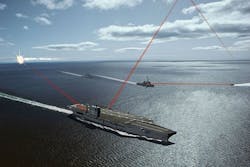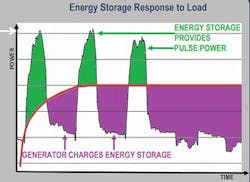IntraMicron eyes high-power battery systems to support power-hungry shipboard laser weapons and radar
Officials of the Naval Surface Warfare Center Philadelphia Division in Philadelphia, have announced their intention to award a sole-source contract to IntraMicron to develop prototype 1,000-volt battery cabinets and thermal management systems using microfibrous media with phase change materials (MFM-PCM) to help meet the Navy's future needs for shipboard pulse power.
The upcoming Small Business Innovation Research (SBIR) phase-three contract will be a follow-on to earlier phases of development. The value of the upcoming contract has not yet been released.
Future naval capabilities will require a 1,000-volt DC to add energy storage capacity needed for future weapons and shipboard systems, Navy experts say. The Naval Surface Warfare Center, Philadelphia's Machinery Research and Silencing Division is responsible for research into high-energy power distribution systems aboard ship for laser weapons and other power-hungry systems.
Related: Demand for shipboard power generation and control has no end in sight
IntraMicron engineers will develop a prototype 1,000-volt DC battery by combining a newly developed and patented battery cooling technology developed by Auburn University and IntraMicron, with lithium ion batteries from K2 Energy Solutions in Henderson, Nev.
Experts from IntraMicron and Auburn University have developed bench-level battery pack prototypes that can operate safely at discharge rates nearly four times greater than those currently available to the Navy, officials say.
IntraMicron and Auburn University also have developed and patented MFM-PCM-based battery cooling technology to enable packs of lithium-ion batteries to operate for extremely high pulse power applications. K2 Energy, meanwhile, has developed suitable mid-form power cells.
MFM-PCM technology involves a porous, sintered, nonwoven support structure that traps catalysts, sorbents, and other desirable materials in a fixed-fluidized bed configuration.
Metal and alloy microfibers are ideal for cases that require enhanced heat and electrical conductivity. IntraMicron also can develop MFM-PCM technologies from polymers, ceramics, glasses, and alloys using the company's proprietary wet-lay and sintering process.
The IntraMicron 1,000-volt DC prototype battery system initially will consist of 20 to 22 lithium-ion battery packs, and will have a battery management system, an electrical interface, a cooling water interface, a venting channel, safety sensors, and safety controls.
Later, IntraMicron experts will explore the possibility of inserting carbon fibers or carbon nanotubes into the MFM-PCM matrix for weight reduction and improved system performance. These prototype batteries will go through testing at the Naval Surface Warfare Center Crane Division in Crane, Ind.
IntraMicron's experimental high-energy battery work is part of Navy initiative called Energy Magazine, which aims at providing pulse power and load leveling when shipboard generators cannot meet immediate demand.
Navy designers have identified advanced sensors and advanced weapons as primary drivers for future power requirements aboard surface warships. Future naval vessels with electric propulsion also will require large amounts of electric power to deploy, maneuver, and reallocate power to mission systems.
The Navy's needs for pulse power varies from less than a second for future radar systems to several seconds for future laser weapons and electrical aircraft carrier catapults. Small directed-energy weapons, for example, will require hundreds of kilowatts of power, and present a pulse load to the DC power source.
To do this, Navy experts are looking into combining energy storage with the ship’s power system instead of developing individual energy storage for every need. Such a system could offer different ramp rates, multiple-transient take-up capability, and handle short- and long-term electrical loads.
For more information contact IntraMicron online at www.intramicron.com, or the Naval Surface Warfare Center Philadelphia Division at www.navsea.navy.mil/Home/Warfare-Centers/NSWC-Philadelphia.
Ready to make a purchase? Search the Military & Aerospace Electronics Buyer's Guide for companies, new products, press releases, and videos

